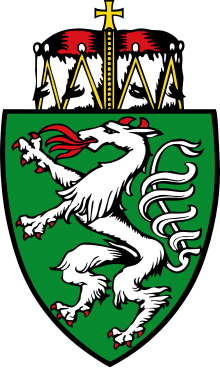Styrian coat of arms
The Styrian coat of arms shows a silver, red-horned and red-armored, flame-breathing panther on green, the Styrian panther . The shield is crowned with the ducal hat of Styria .
“The coat of arms of the country is the red-horned and armed silver panther in a green shield, which pokes flames from the throat. The coat of arms is wearing the historical hat. "
The Styrian Panther
The panther, as the heraldic animal of Styria, first appeared in the seal of Margrave Ottokar III in 1160 . handed down from the Traungau family . When Styria was elevated to a duchy in 1180, the family coat of arms was transferred to the country. The mythical creature, which originally belonged to the blue-white group of the Bavarian-karantan "panther family", is the significant coat of arms of the margraves, later dukes of Styria, who were named after their lead name as Otakare and who had their ancestral seat in Steyr.
1160 by Margrave Ottokar (Otakar) III. Chosen by Steyr as his official shield coat of arms, it still forms the Styrian state coat of arms today.
The coat of arms was first described in detail by the chronicler Ottokar from the Gaal , who documented around 1315 how the Styrian nobility fought alongside the Bohemian King Ottokar II Przemysl in 1253 against the Hungarians under King Bela IV . As state marshal, Herrand von Wildon carried the flag described as
"A banier green as a grass / in it a pantel swebte / blanc, as if ez was alive"
In its current form, the coat of arms has been valid since 1926 - the modification at that time concerned the flames that previously licked out of all body orifices (mouth, ears, but also phallus and anus ). The state parliament member Frida Mikula enforced the abolition of fires from the body orifices except for those in the area of the mouth because of "obscenity".
The coat of arms emblazoned itself around Leopold II. 1790:
"A right-looking, upright silver so-called panther animal with an upwardly curled tail, from whose throat and all openings of the body flames go, in the green field because of the Duchy of Steyermarkt."
The heraldic animal in the old form can be found today in the coat of arms of the Styrian capital Graz .
Heraldic research today also points out the strong symbolic effect and tradition of the Styrian coat of arms: “The Styrian heraldic animal has [...] become a quasi-living symbol of Styrian independence. With the possible exception of the Tyrolean eagle , no coat of arms of the Austrian federal states can match it in terms of identity. [...] The Styrian coat of arms has been in use in practically unchanged form for more than 750 years. Together with the red-white-red shield it is one of the oldest and most venerable state symbols in Europe. "
Picture gallery
Ducal full coat of arms ( Hans Burgkmair the Elder , 1523)
Coat of arms of the Duchy of Steyer during the Austro-Hungarian monarchy ( Hugo Gerard Ströhl : Austria-Hungary's coat of arms. 1890)
Styria in the auditorium of the Palace of Justice in Vienna
The old Styrian panther in today's coat of arms of the city of Graz , crowned with gold
The eponymous city of Steyr also carries the heraldic animal
Kainbach near Graz : a lion and a panther
Mödling : above the Bindenschild (Austria), below the panther
literature
- Peter Diem: The symbols of Austria. Time and history in signs . Kremayr & Scheriau, Vienna 1995 ISBN 3-218-00594-9
- Alfred Anthony von Siegenfeld : The state coat of arms of Styria. Graz 1900.
Web links
- Office of the Styrian regional government: Styrian coat of arms , historical representations
Individual evidence
- ↑ Diem (1995), p. 341.
- ↑ Matthias Werner: Late medieval national consciousness in Germany . Jan Thorbecke Verlag, Ostfildern 2005 ISBN 3-7995-6861-1 p. 177.
- ↑ For example: Otto Posse: The seals of the German emperors and kings . Wilhelm and Bertha v. Baensch Foundation, Dresden 1913, supplement: Wapen and Titeln Sr. Kaiserl. Royal Apostol. Majest. Leopold des Zweyten, elected Roman Emperor, King in Germania, Hungary and Boheim, Archduke of Austria, etc. together with their heraldic description. Vienna 1790. Section Heraldic Description of the Great Kaiserl. Royal Archduke Heraldic shield or seal. , S. 246 , col. 2 ( Wikisource ).
- ↑ Diem (1995), p. 340 and p. 344.










